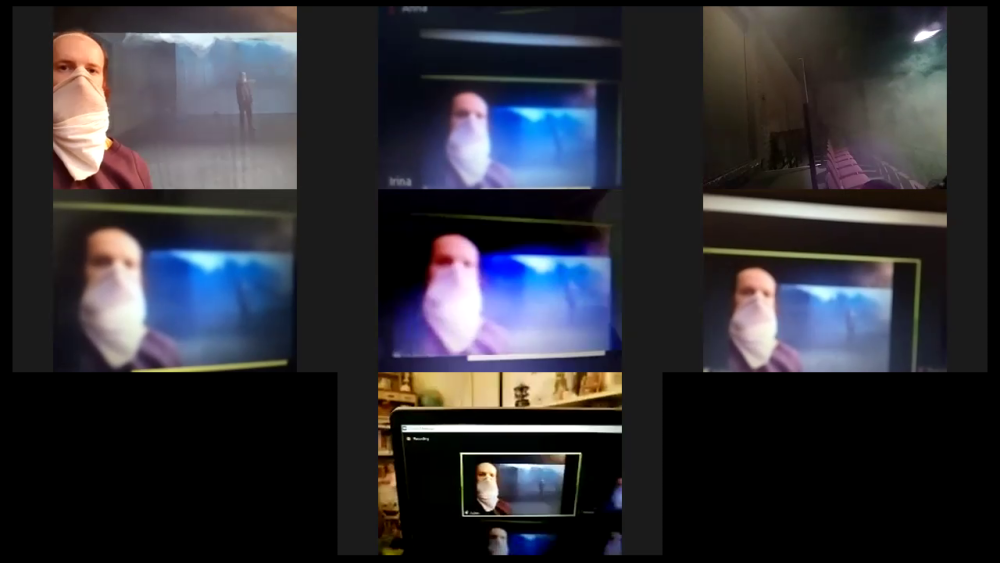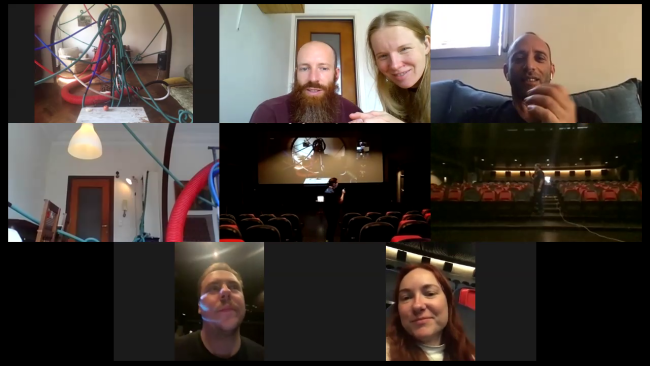How does smoke travel on stage?
a conversation with Irina Lavrinovic and Asher Lev
When COVID hit Belgium and the cultural world locked its doors, Irina Lavrinovic and Asher Lev felt the need to use their artistic perspective to try to understand the very confusing reality unfolding in the world. It resulted in their first live online performance, Ms 5G & The Respiratory Machine, that premiered during the first lockdown in Belgium, April 2020 on Zoom. In February 2021 they resided at the Kaaistudio’s in the framework of How to Live & Work Now to explore further possibilities within this new format.
What was the motivation for making your first live online performance during the lockdown in the spring of 2020?
IRINA LAVRINOVIC & ASHER LEV: The discourse on the corona crisis is mainly determined by politicians and scientists. We felt from the beginning that artists should be part of the discussion because what is going on, is not purely a scientific or political question. It’s more of an aesthetic question on how you want to live your life. Here we follow Nietzsche, who replaced regular ethics with the idea of the aesthetic. We think the voice of artists should be as important as that of anybody else. Especially performance artists because their work is about being in the present moment and they can react immediately. That’s why whatever we do has to be live, which motivated us to research the medium of the live online performance.
Your first project was broadcasted from your living room. For the residency at Kaaitheater, you decided to come back to the theatre space. Why?
IL&AL: Even in our living room we made a little theatre. We used theatre references and the tradition of the stage, the frontality. Our work normally leaves the strict tradition of the theatre, but our origins are still there. Whatever was going on in a theatre at that moment, in our imagination it felt very inspiring. The theatre was dead but the spirits of the theatre were keeping it alive somehow. We wanted to discover that life with those spirits, through creative aesthetic engagement with the building, the tradition and the context.
We also wanted to bring our new practice of live performances online into the theatre to see what happens. How can the physical theatre, with its stage, logistics and techniques meet with this online medium?
How was it to rediscover the stage you know so well, when coming from this new online experience?
IL&AL: It was very interesting, because we didn’t come with specific content to work on. During the first week of our residency, we wanted to make the stage come alive, be festive, with light, sound and smoke. The stage and theatre became our object of observation: how does smoke travel on stage? How does it look like through the camera? What kind of language does it produce when filmed?
Afterwards, we did a performative experiment with some KASK students and fellow performers. For now, we call it an ‘online relay performance score’. We tried out a certain layering of virtual spaces into each other in order to feel the aliveness of the Internet medium, through which the performance was happening.
The question behind the experiment was ‘how can the theatre perform itself differently’? What is the role of the performer when you let the theatre perform itself?
IL&AL: With this question, we tried to see if the theatre can perform itself differently today by expanding into other spaces through the virtual realm. What is a potential way of connecting the space of the theatre to other spaces? In the experiment, some of us were in the theatre space, some were elsewhere. The first person in the theatre started interacting with the space she was in and then, with her camera zoomed in on the next person’s screen. This way, the camera exited the theatre and entered other spaces.
Without the performer, the theatre is just a building and we realised that the experiment became much more about the story of the performer holding the camera. There is a still long trajectory of possibilities to research, looking for a more complex relation between someone holding the camera, being in front of the camera and guiding it through the space.
You have already talked about the liveness of the performances, but how can you assure your audience that the performance isn’t recorded from beforehand ?
IL&AL: That is a very profound question which we spend a lot of time thinking about. You can sort of fix that in many different ways. One of the answers that we came up with for now is that in order to feel the aliveness of the performance, you need to be in the space where the performance takes place. You need to share that space with the performer, even if it’s a non-human performer. The question then arises: what is that space where an online performance takes place? When you go to the theatre, you go into the building, you sit in front of a podium, you feel like you’re in the same space where the performance is taking place. In order to feel that you are in the same space where the performance is taking place when it is online, you get a link and log into the Zoom meeting. For Ms5G & The Respiratory Machine, we had someone welcoming the audience, inviting them for the after-talk afterwards and explaining that we were having a shower and getting ready for the after-talk. The real “proof” we came up with in the end, was to turn the camera towards the screen of the Zoom meeting, so the audience could see itself watching the performance. This also inspired us to do the relay experiment during our residency.
It seems like there still are a hundred things to explore here. What is your next step?
IL&AL: We will continue exploring the online relay performance. We want to work with the Internet as a medium which connects many spaces in one. We also want to embrace this when it becomes tangible, when the connection slows down or even breaks down. We are very invested in how to experience the aliveness of the medium of the Internet. A whole world opened up for us through the score we created for the relay experiment, and we want to give aesthetic value to all of these things that people usually try to ignore or see as noise.
Another thing we want to work on is something we already started doing during our residency: looking for already existing live online performances – though they’re not called as such – and frame them. We’re looking at webcams in public spaces and we’re trying to find out how we, as artists, can say that this is a live online performance. At the moment, we are focusing on the webcam at Place de Brouckère. The images of this camera are broadcasted on the website brussels.be 24/7. We’re working with the frame of the webcam image. The edges of this frame are places of increased tension, where the physical leads to virtual, because that’s where a person “falls into” the frame or “falls out” of it. During the residency, we were working with a dancer on that frame, to see what it means to be in a physical space and deal with a virtual frame at the same time.
We’re also taking this concept to the Dance Day together with ZSenne Art Laboratory. We will attempt a form of engagement between the frame and the people that are enter the square. The idea is to open up the awareness that there is a performance taking place physically, as well as in the online public space. In that sense, anyone passing by can become a performer.
What will you personally take with you from this residency?
IL&AL: We noticed how the theatre house is actually shaping this virtual body. Before, it had a mostly physical body, but now, the technical department is updating their technology and cameras, for example. When we had certain questions, we would ask and they would spend some time teaching themselves how to use this or that. It was very interesting to see how we all are slowly transforming, changing our body somehow.
The old programmes and brochures are still in the foyer. You encounter a very recent past, but it is indeed a past. Suddenly, you feel like you are in a deserted, abandoned building. A place known as a place of presentations now filled with the sounds of creativity, research, learning, studying. You could feel this in the building itself.

